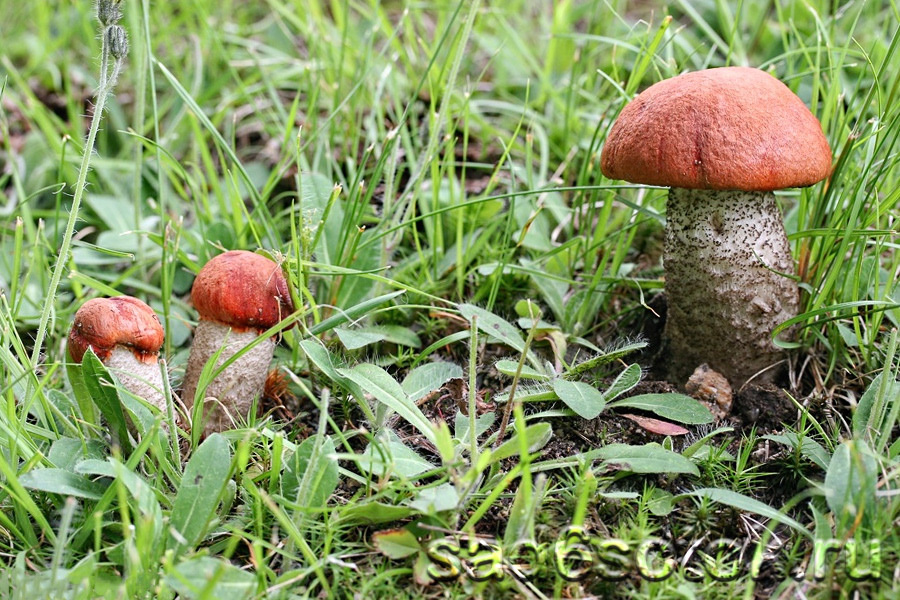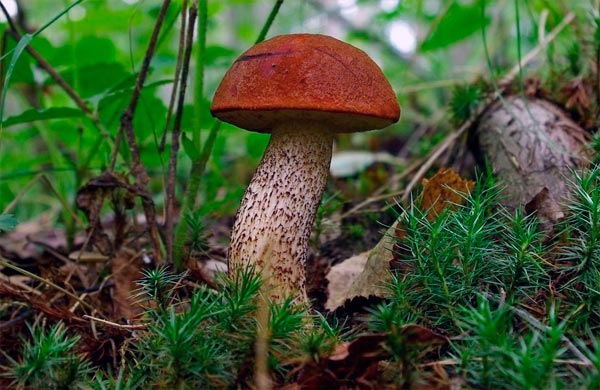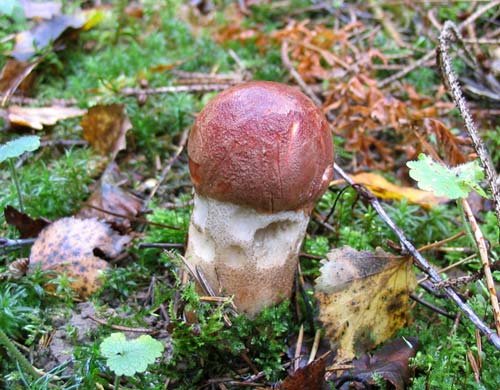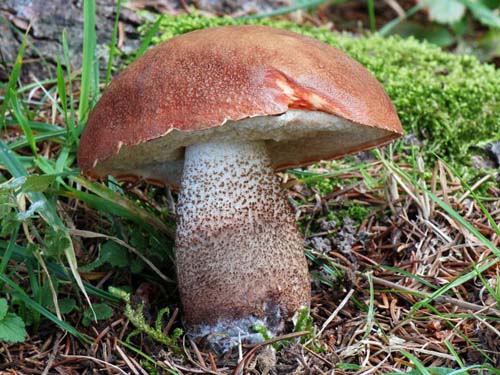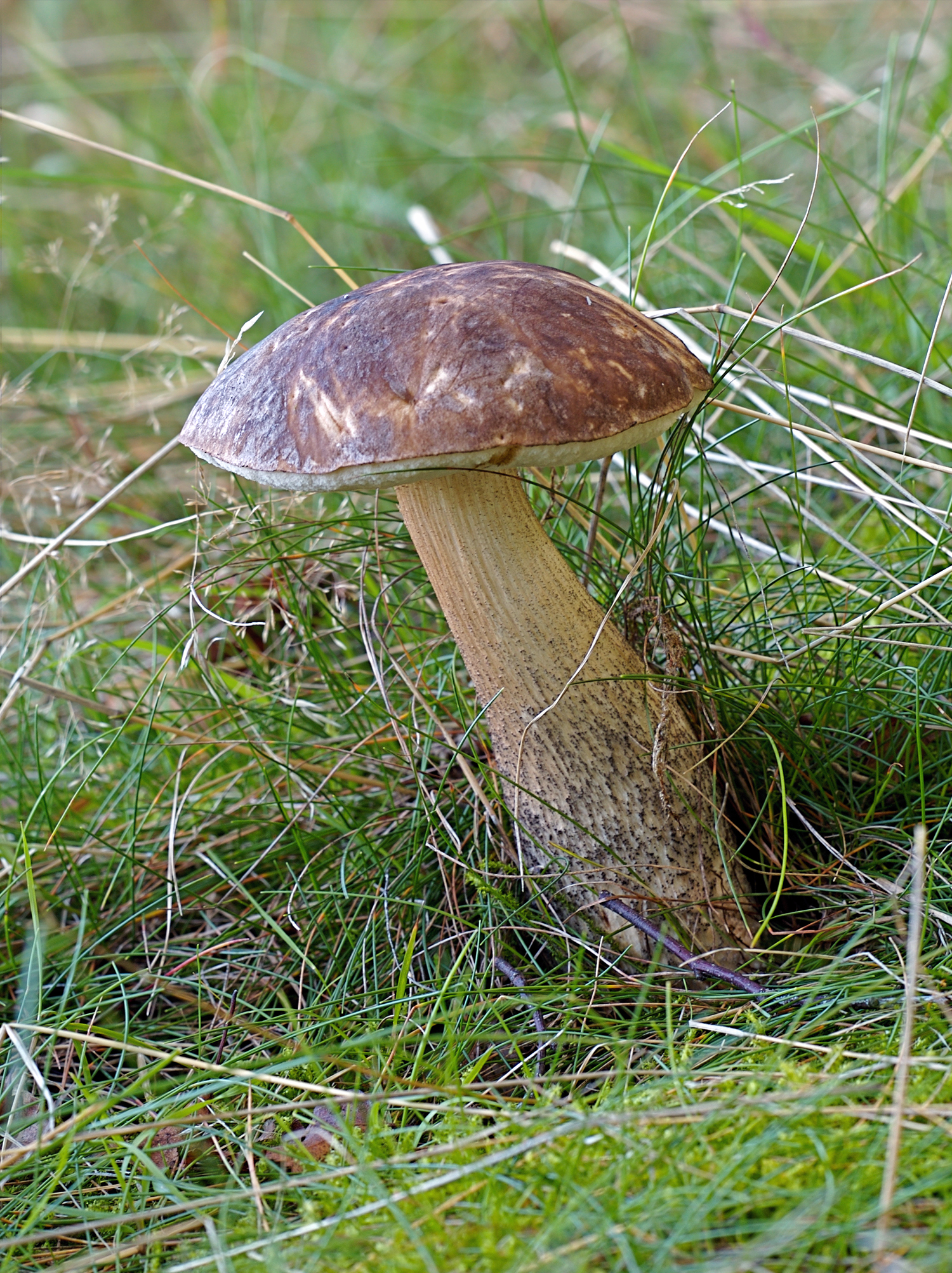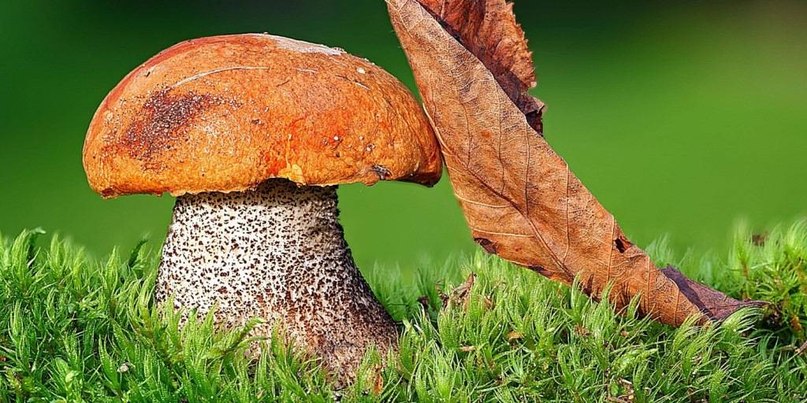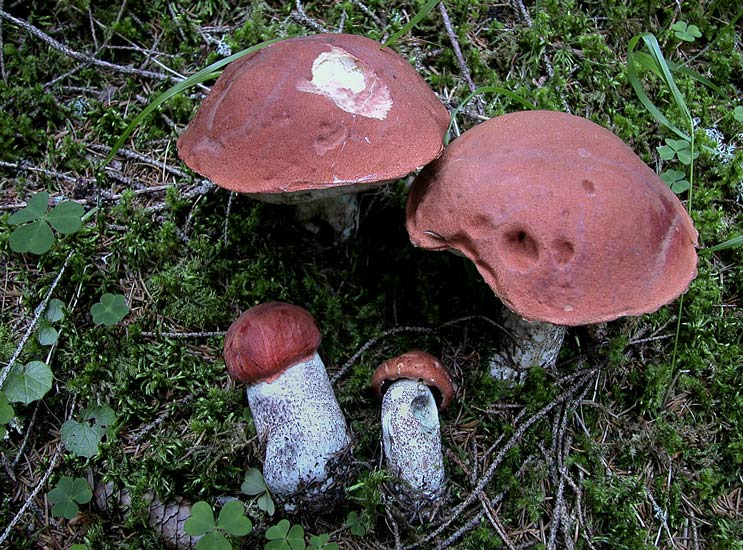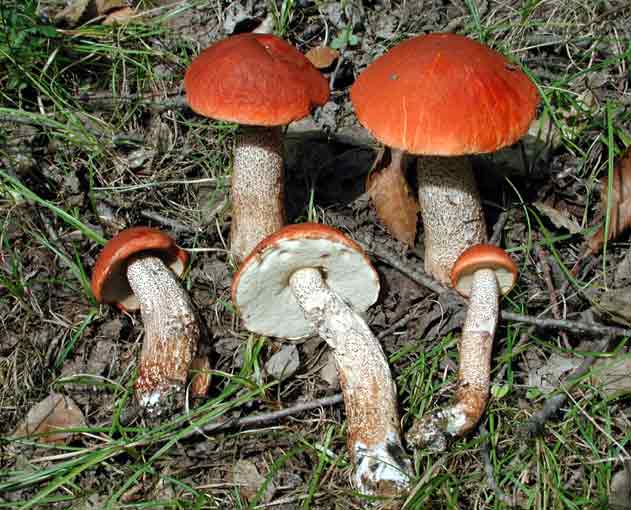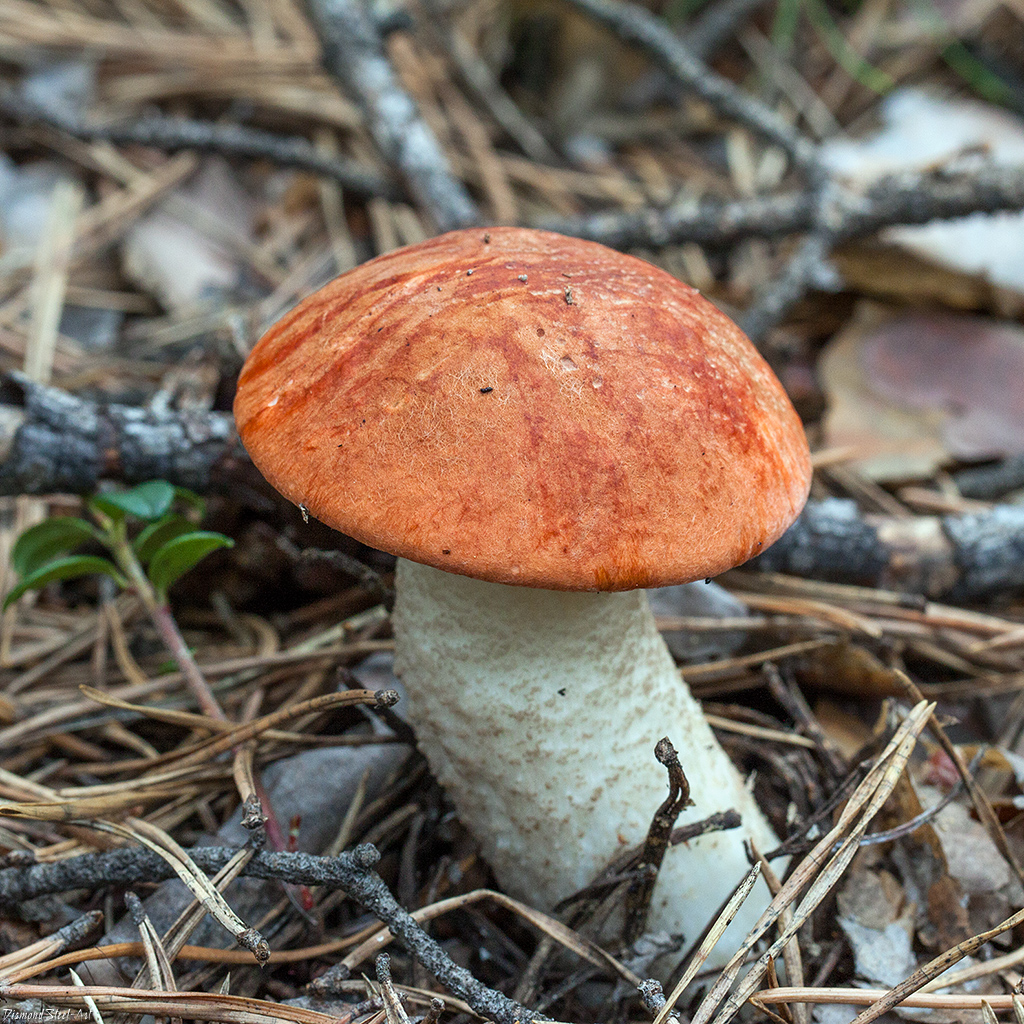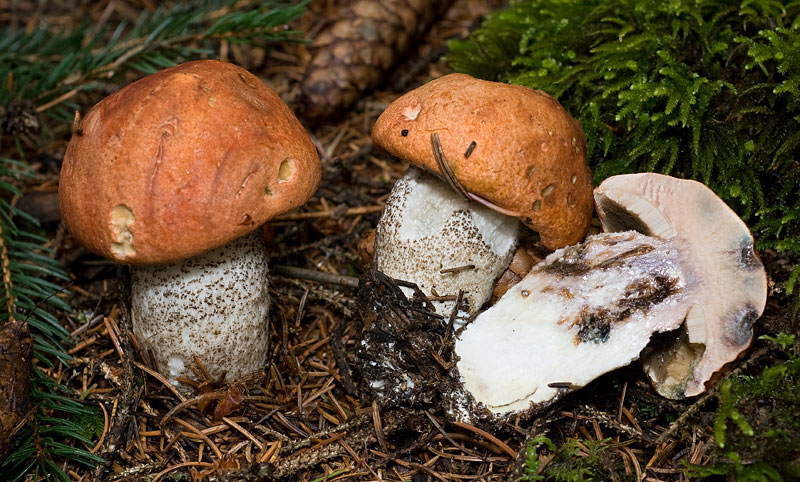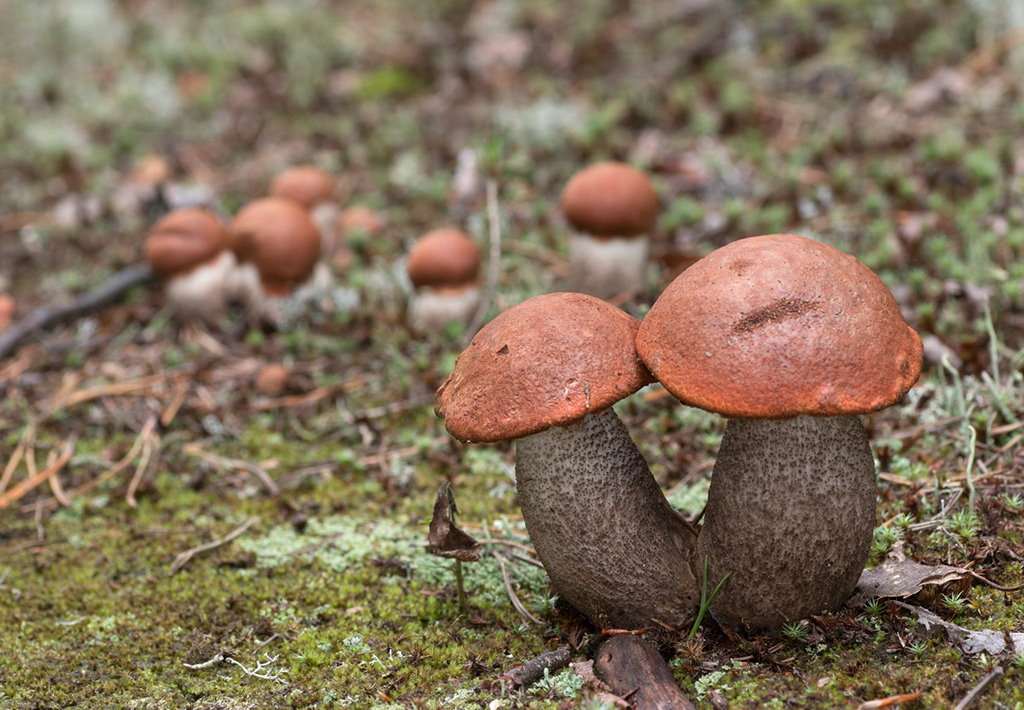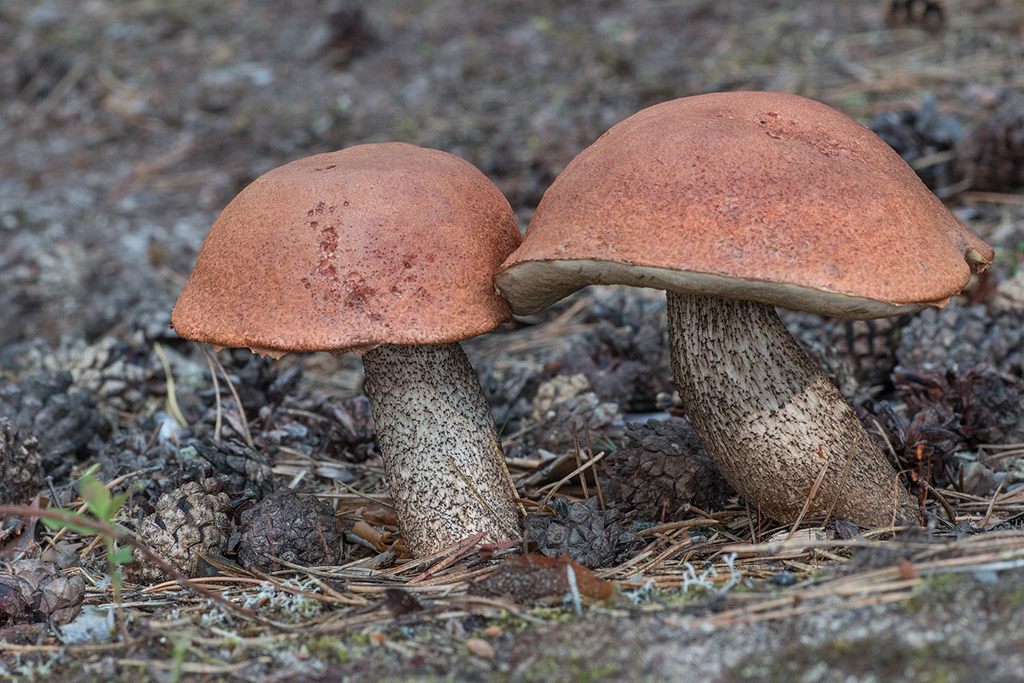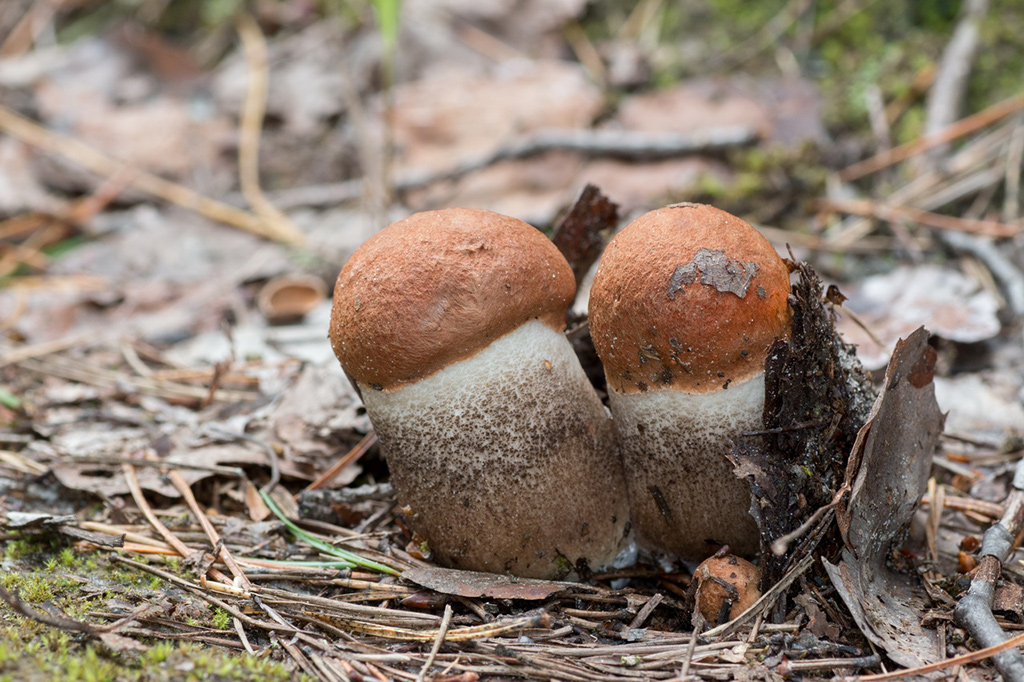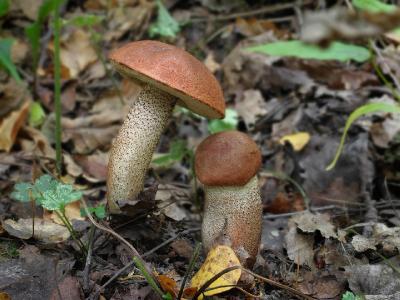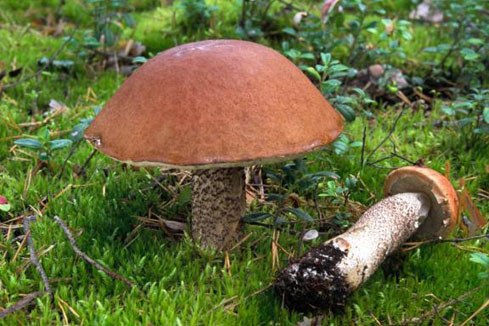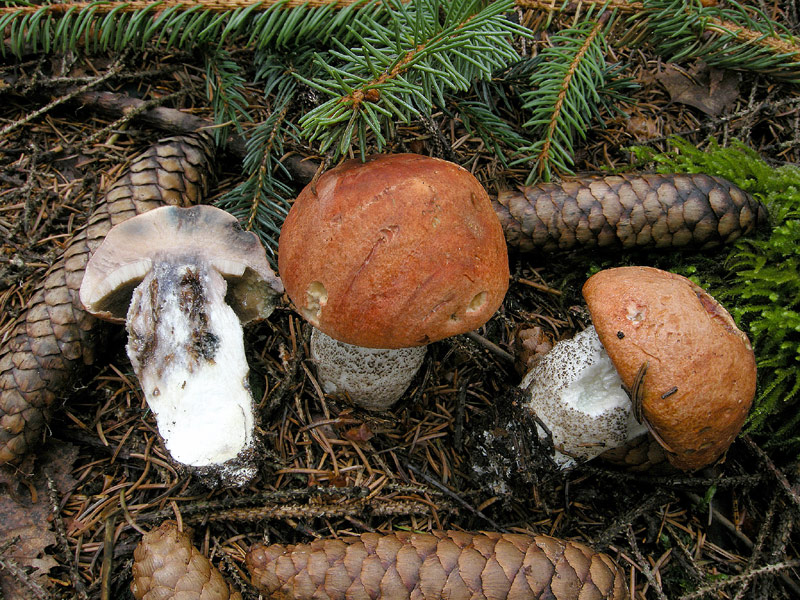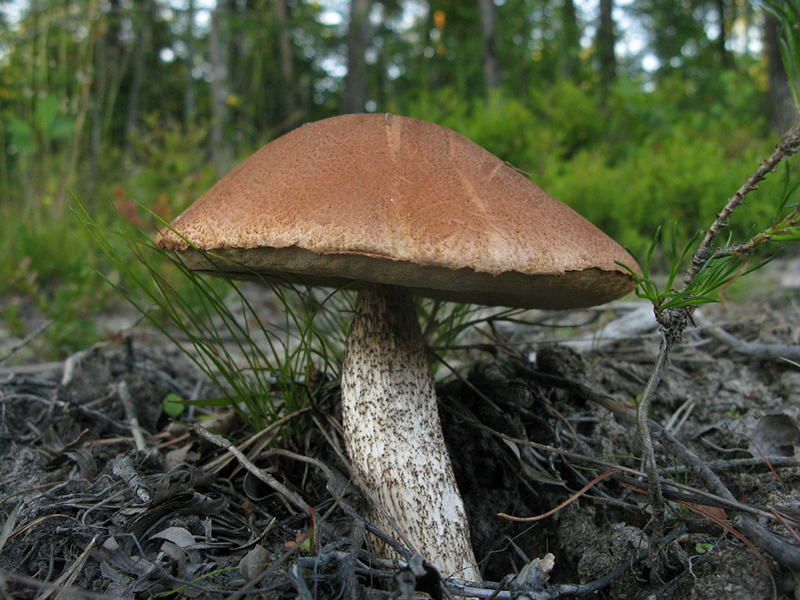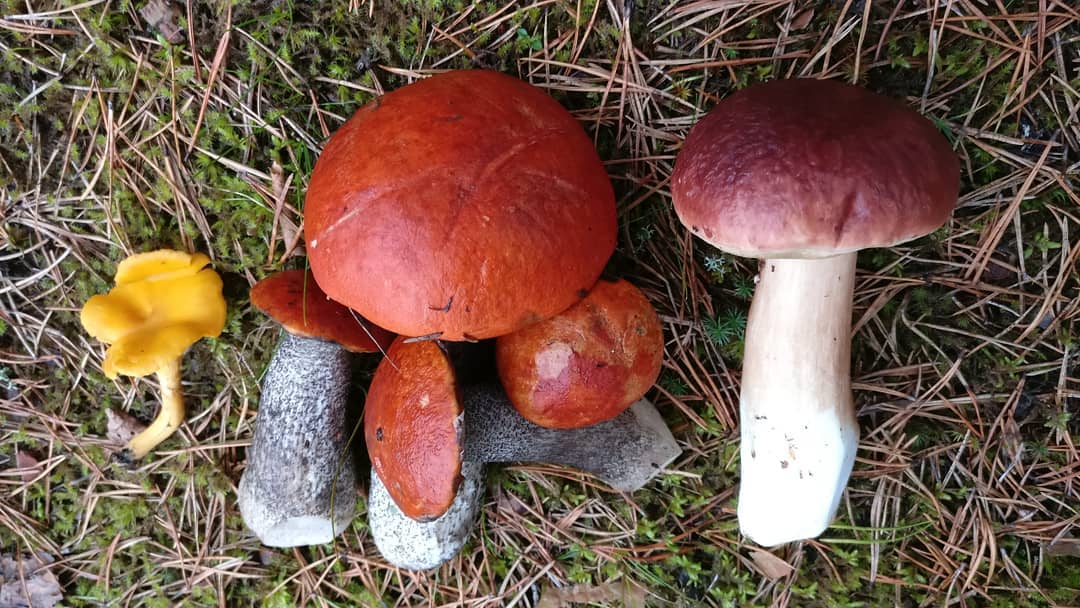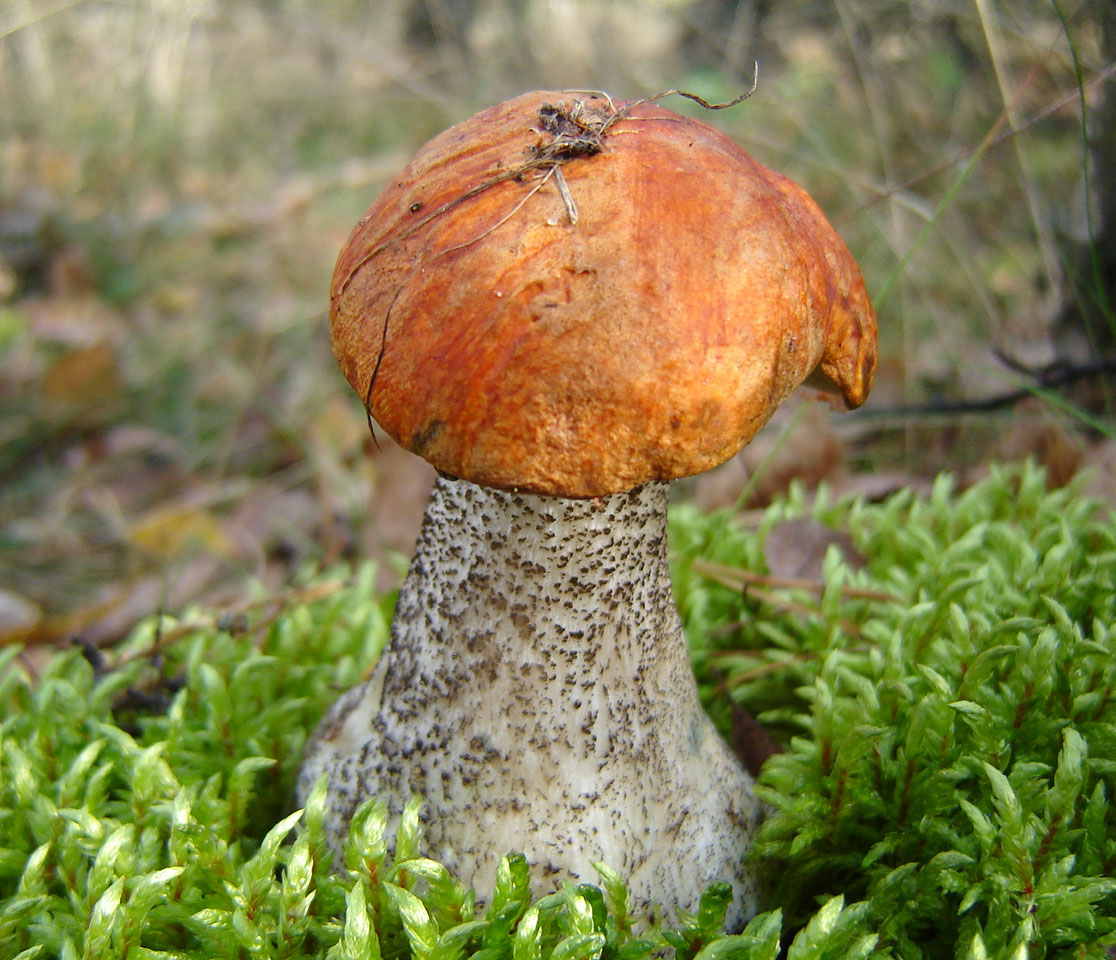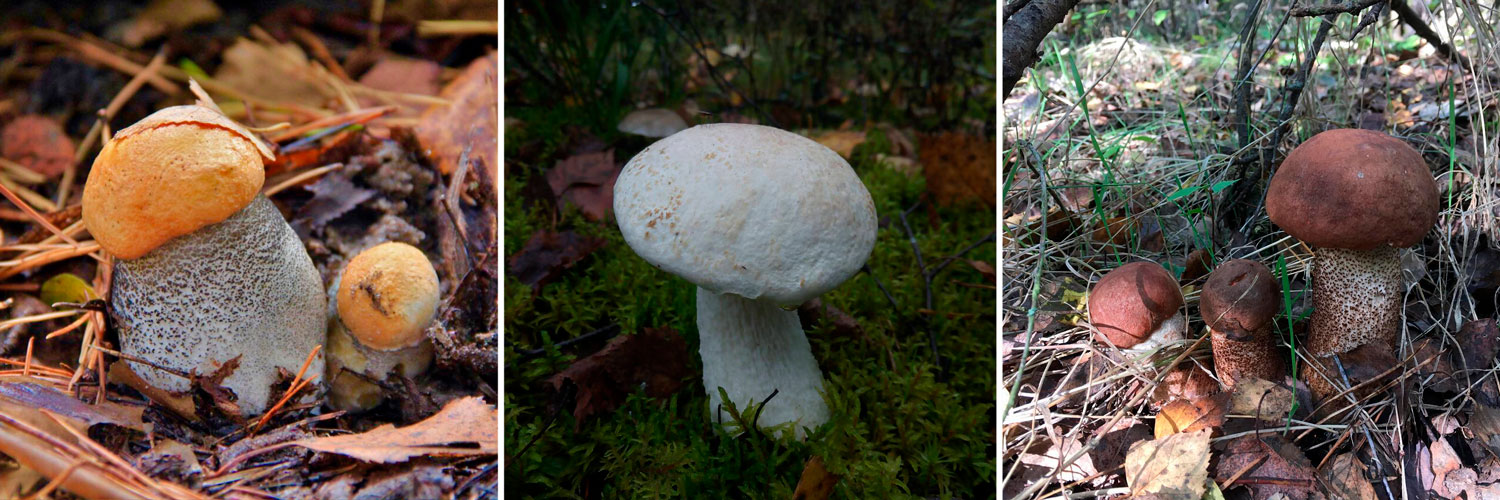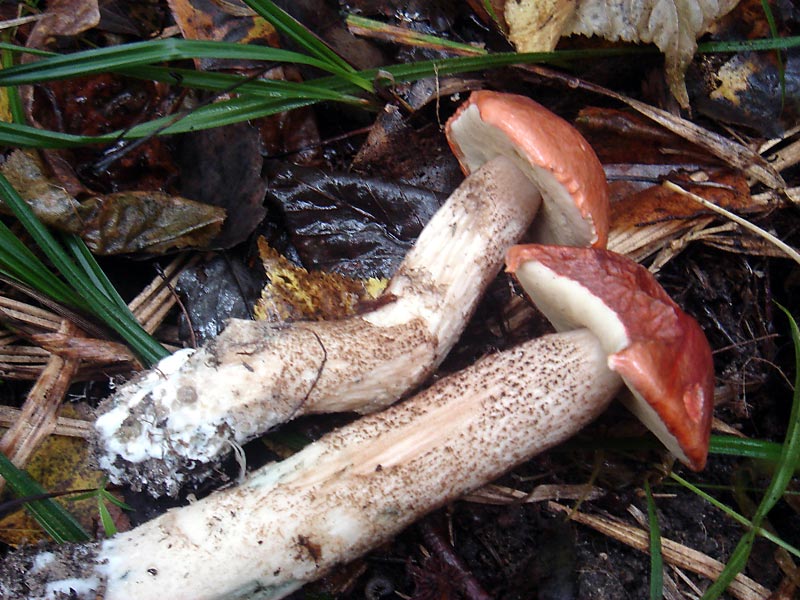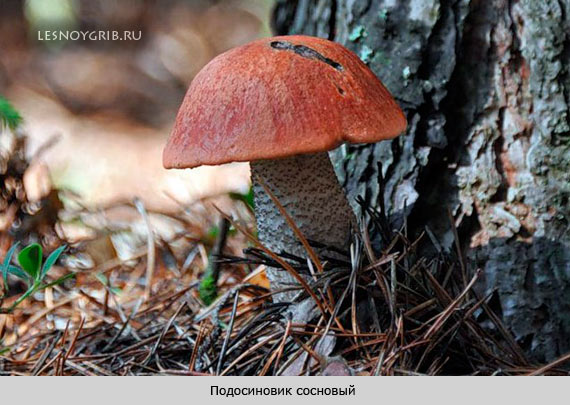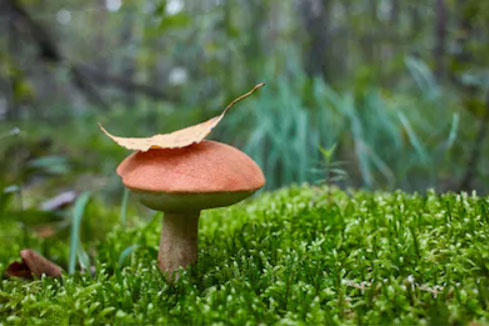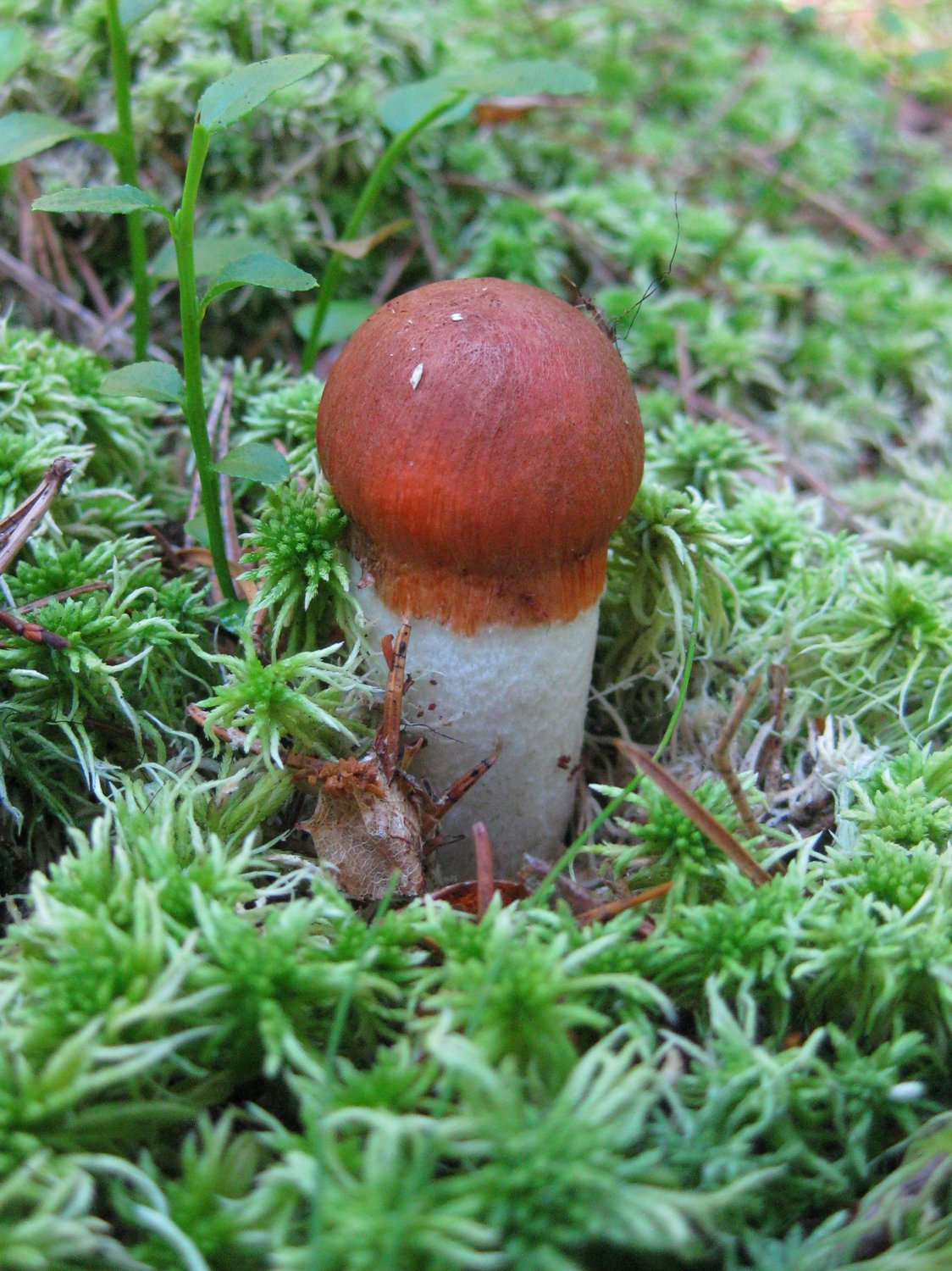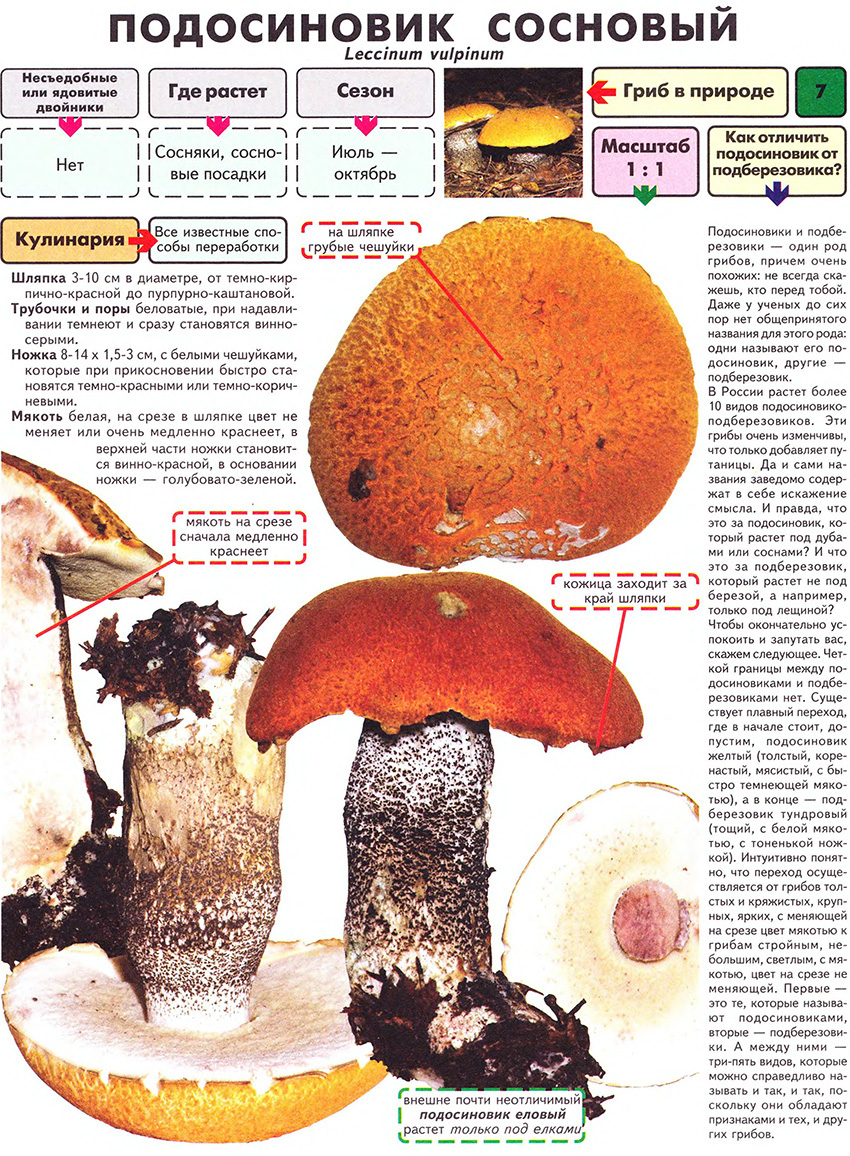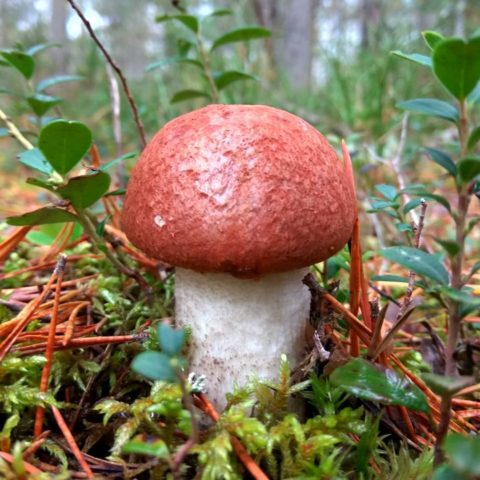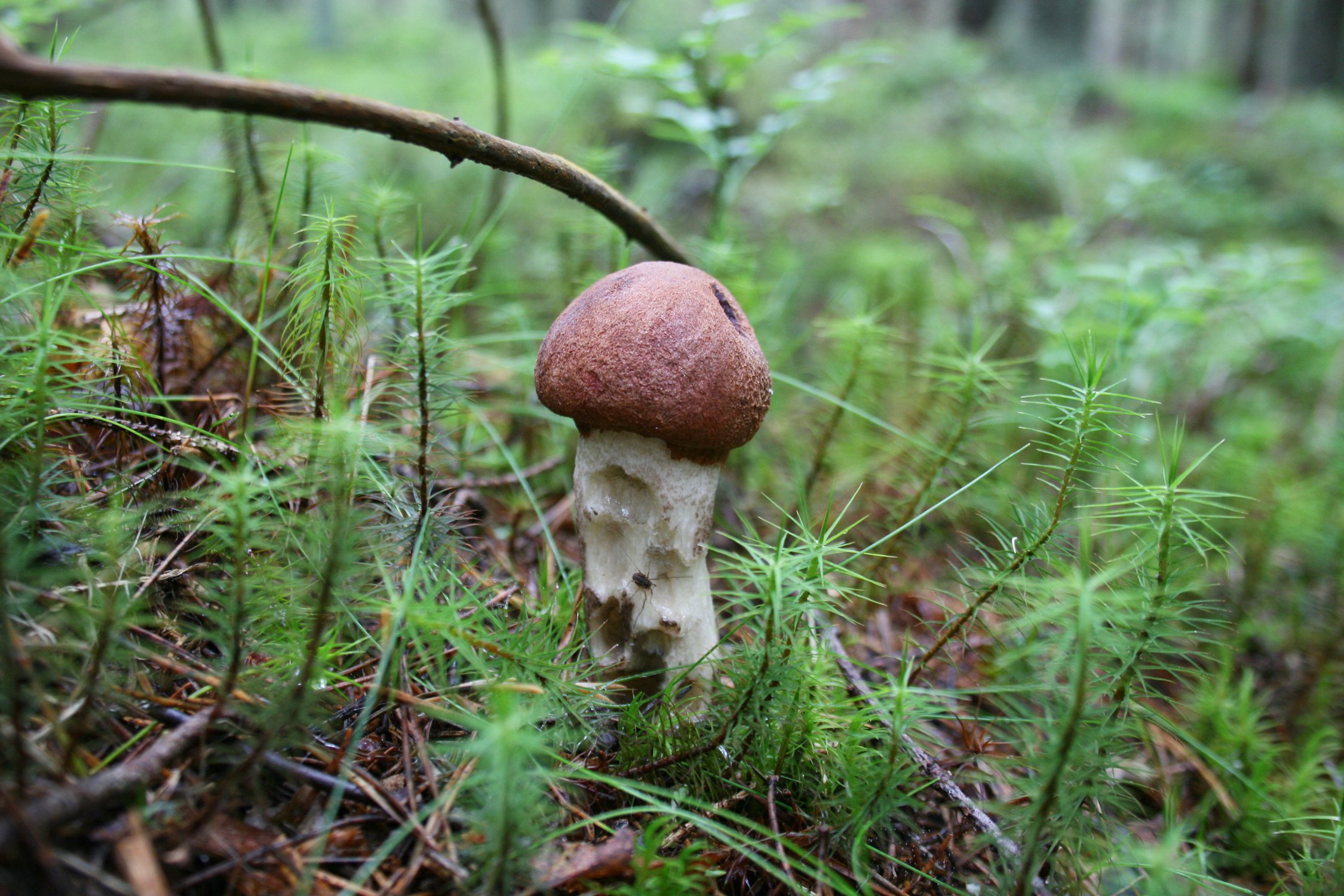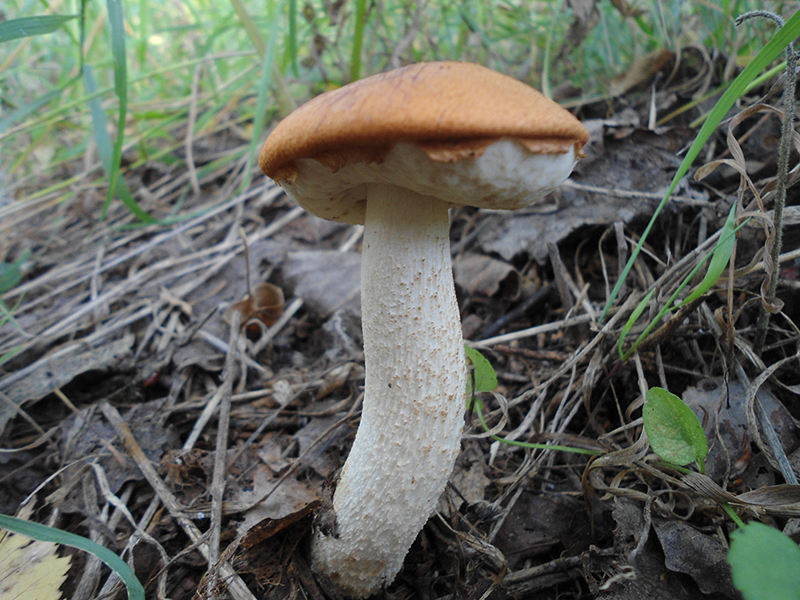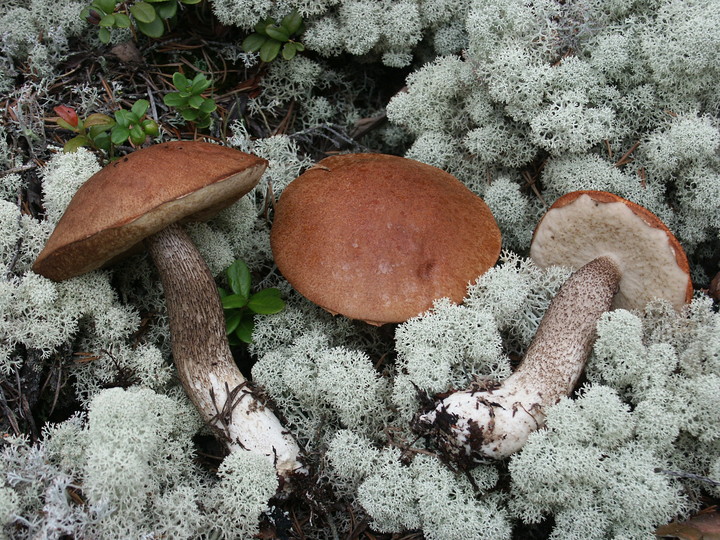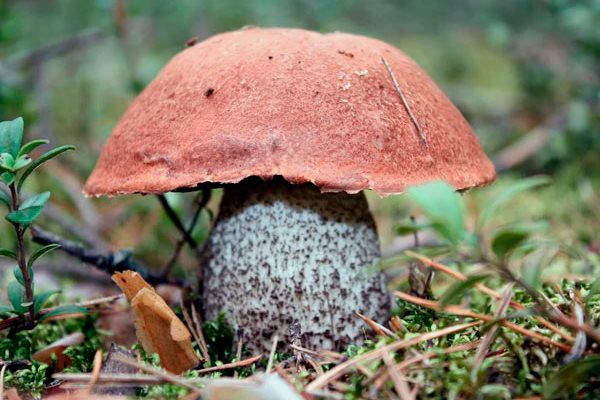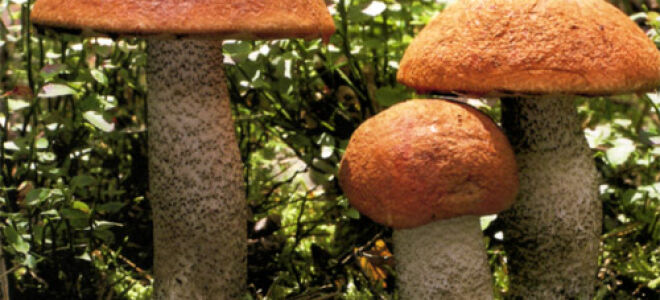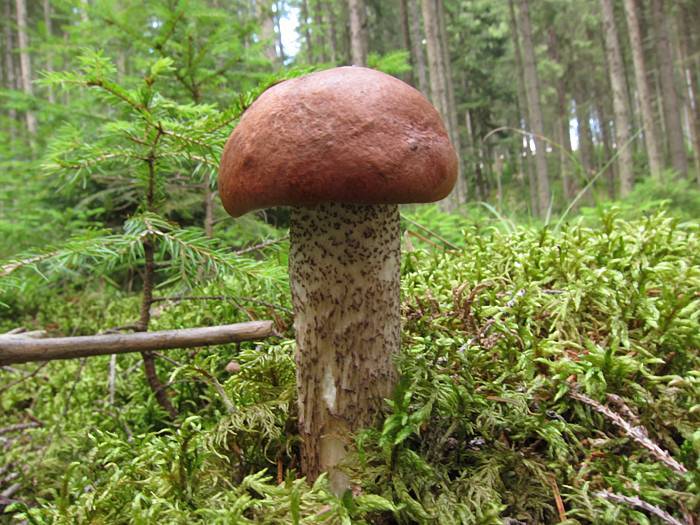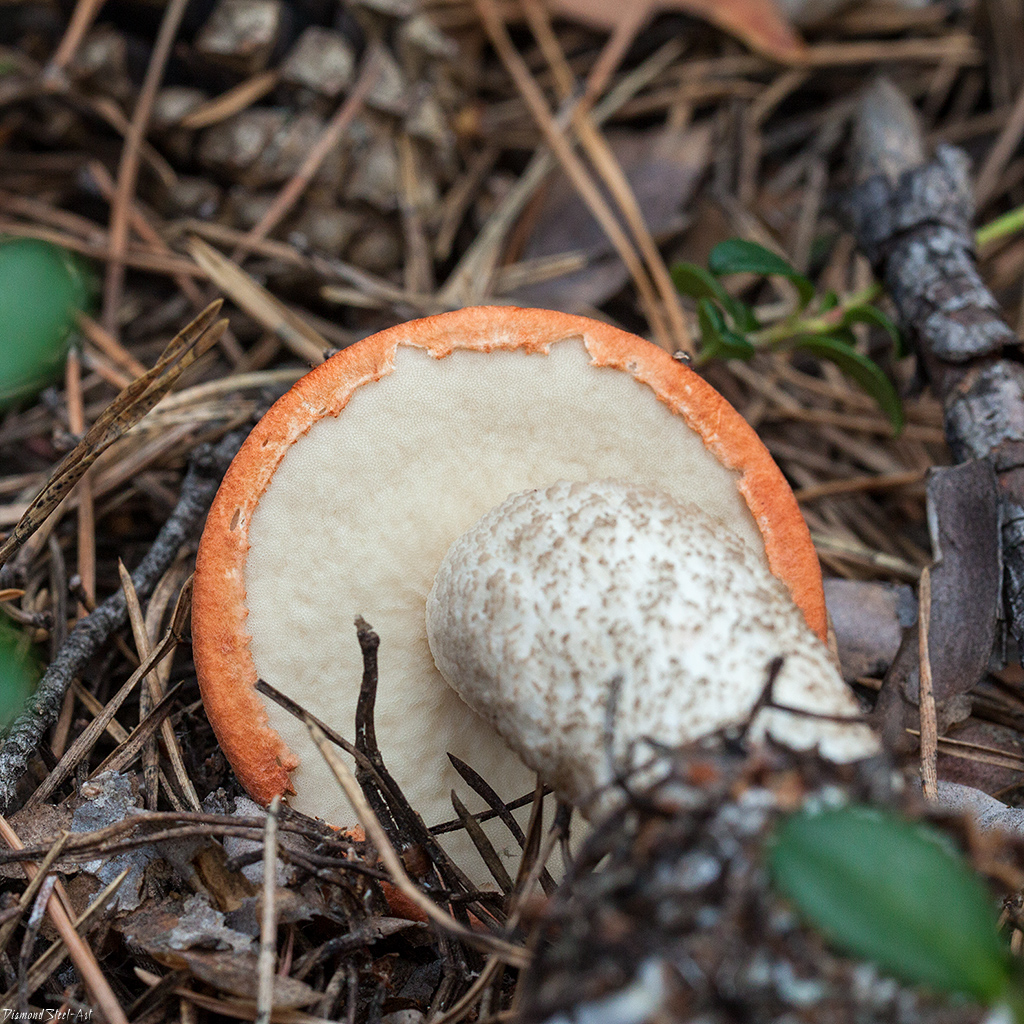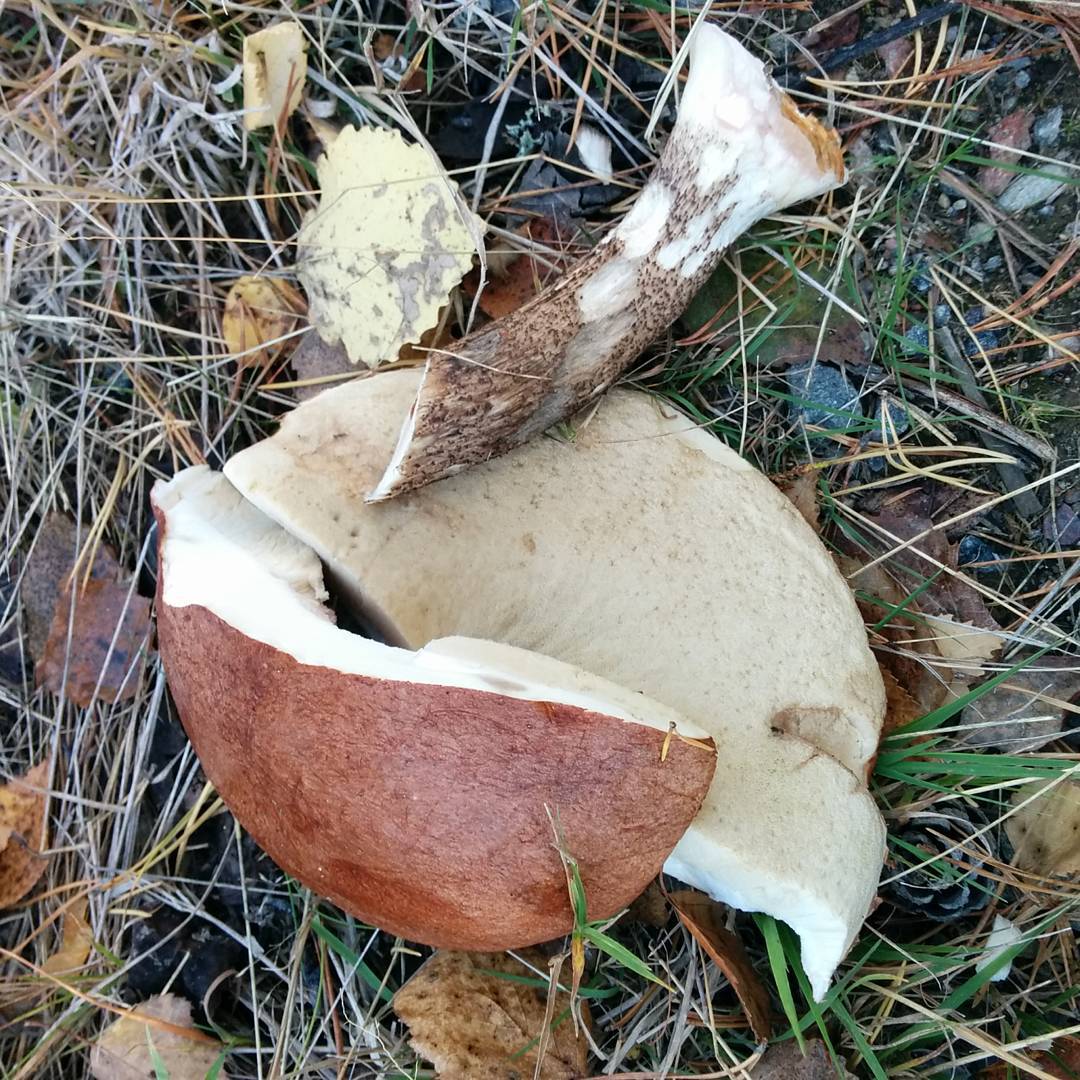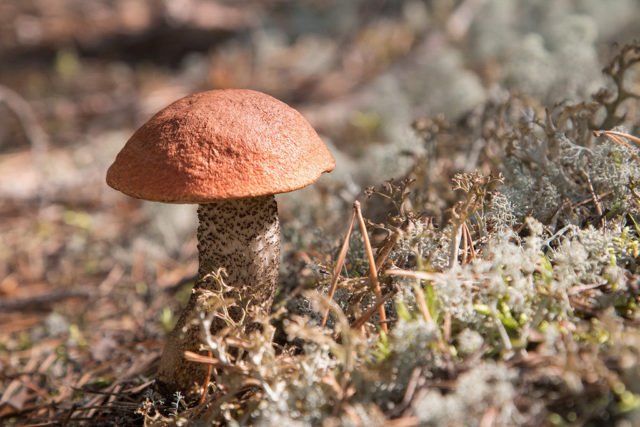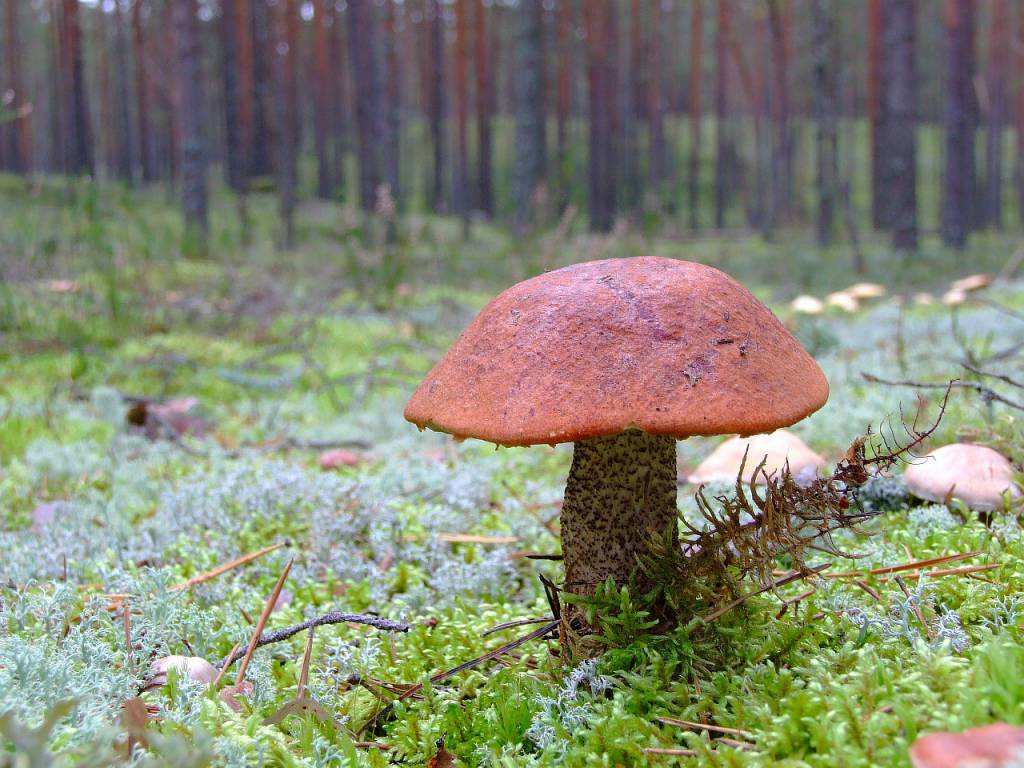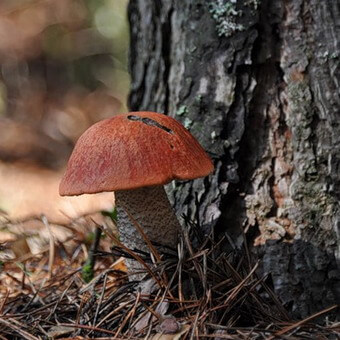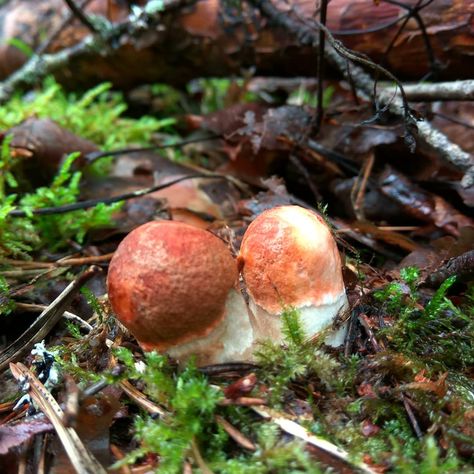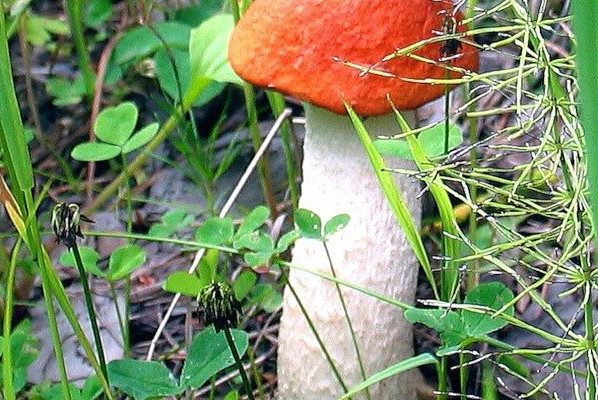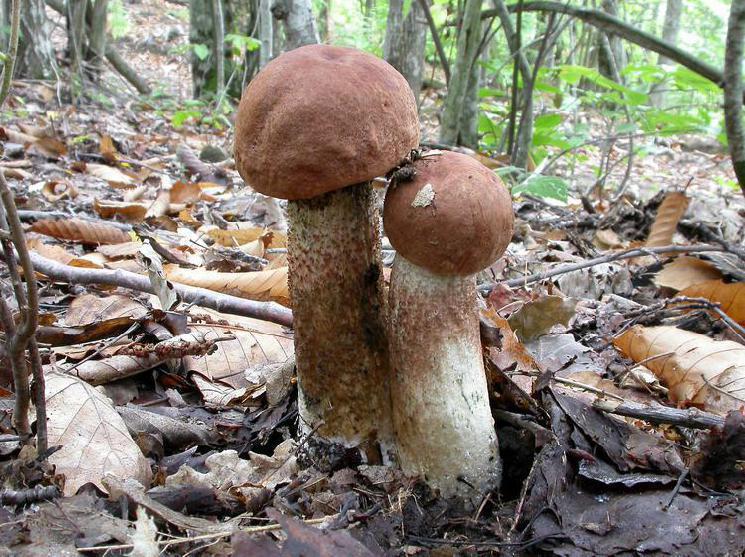Description
Aspen is so called because of mycorrhiza formation mainly with aspen. This appellation unites a genus of edible mushrooms with rather slight differences between species.
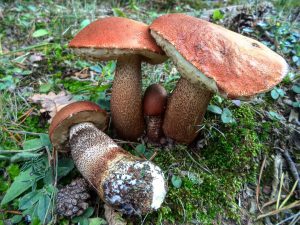 Hat
Hat
A young oak boletus has a hemispherical cap, and then a dome-shaped one. The color of the cap is brown. The surface of the cap is always dry and smooth, and cracks in the absence of precipitation for a long time. The hat can grow up to 15 cm across.
Leg
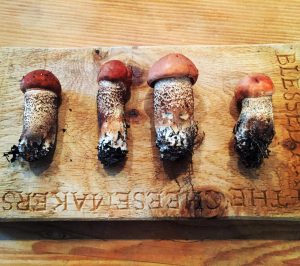 The oak boletus has a thick and long leg - 15 * 5 cm in length and thickness, respectively.
The oak boletus has a thick and long leg - 15 * 5 cm in length and thickness, respectively.
Its shape is cylindrical-clavate (almost throughout the entire length it is a cylinder, but the base is clavate widened).
At a young age, the leg of this fungus is almost white, in older specimens it is brownish. The surface of the leg is rough due to scaly outgrowths on it. In oak boletus, these outgrowths are red in color.
Spore-bearing layer
 The spore layer of oak boletus, like other representatives of the genus, is made of tubules. In young specimens, the hymenophore is light gray, and with age it darkens more and more (to gray). The pores of the tubules are uneven and finely meshed.
The spore layer of oak boletus, like other representatives of the genus, is made of tubules. In young specimens, the hymenophore is light gray, and with age it darkens more and more (to gray). The pores of the tubules are uneven and finely meshed.
Pulp
The pulp of oak boletus is unevenly colored, white-gray. When cut, it quickly changes color from gray to blue, and then black. The consistency of the pulp is firm, without any special taste or smell.
Spore powder
For the most part, the spore powder of oak boletus is yellowish-brown. The spores are large, fusiform.
Definitioner
- Basidia (Basidia)
-
Lat. Basidia. A specialized structure of sexual reproduction in fungi, inherent only in Basidiomycetes. Basidia are terminal (end) elements of hyphae of various shapes and sizes, on which spores develop exogenously (outside).
Basidia are diverse in structure and method of attachment to hyphae.
According to the position relative to the axis of the hypha, to which they are attached, three types of basidia are distinguished:
Apical basidia are formed from the terminal cell of the hypha and are located parallel to its axis.
Pleurobasidia are formed from lateral processes and are located perpendicular to the axis of the hypha, which continues to grow and can form new processes with basidia.
Subasidia are formed from a lateral process, turned perpendicular to the axis of the hypha, which, after the formation of one basidium, stops its growth.
Based on morphology:
Holobasidia - unicellular basidia, not divided by septa (see Fig. A, D.).
Phragmobasidia are divided by transverse or vertical septa, usually into four cells (see Fig. B, C).
By type of development:
Heterobasidia consists of two parts - hypobasidia and epibasidia developing from it, with or without partitions (see Fig. C, B) (see Fig. D).
Homobasidia is not divided into hypo- and epibasidia and in all cases is considered holobasidia (Fig. A).
Basidia is the place of karyogamy, meiosis and the formation of basidiospores. Homobasidia, as a rule, is not functionally divided, and meiosis follows karyogamy in it. However, basidia can be divided into probasidia - the site of karyogamy and metabasidia - the site of meiosis. Probasidium is often a dormant spore, for example in rust fungi. In such cases, probazidia grows with metabasidia, in which meiosis occurs and on which basidiospores are formed (see Fig. E).
See Karyogamy, Meiosis, Gifa.
- Pileipellis
-
Lat. Pileipellis, skin - differentiated surface layer of the cap of agaricoid basidiomycetes. The structure of the skin in most cases differs from the inner flesh of the cap and may have a different structure. The structural features of pileipellis are often used as diagnostic features in descriptions of fungi species.
According to their structure, they are divided into four main types: cutis, trichoderma, hymeniderma and epithelium.
Cm.Agaricoid mushrooms, Basidiomycete, Cutis, Trichoderma, Gimeniderm, Epithelium.
When do boletus boletus grow?
Boletus bears fruit at different times:
- spikelets grow from the end of June and the first week of July, but do not differ in abundance. This period of fruiting includes yellow-brown boletus, white boletus. These are the first boletus that appear in the forest.
- stubble stubs begin to appear from mid-July, bear fruit until August-September and are distinguished by a rich harvest. These types of mushrooms include black-scale boletus, red boletus, oak boletus.
- deciduous trees appear from mid-September and are characterized by a long fruiting period, up to October frosts. Until the middle of autumn, the redhead pine and the redhead spruce grow well, because the coniferous litter in the place of their growth protects the mycelium and already grown mushrooms from the cold for quite a long time.
Black-scale boletus
On the Internet, you can find a mention of such a species as the black-scaly boletus (Leccinum atrostipiatum). Its description is very similar to the description of the red boletus, but black-scaled is most often found in sources from North America, and therefore it is likely that it grows there. On the Russian sites, there is no information about the places of its growth, and most of these sites cannot be considered authoritative resources in the field of mushrooms. Based on this, I decided not to include this boletus in this selection of species, but it was still necessary to say about it.
Why does the boletus turn blue (darken) on the cut
The transformation of the white flesh of the boletus into blue-violet on the cut occurs as a result of the oxidation process, which consists in the interaction of oxygen with the substances contained in the mushroom. Similar reactions are also typical for fruits and some vegetables, for example, if you cut an apple, then after a while its pulp will acquire a brownish tint. This answer will be enough if you do not want to go into the details of chemical reactions. Still, I would like to receive more detailed information on this issue.
After reading various literature, you can find out that the boletus contains a certain pigment - variegated acid. The composition of this pigment includes substances of the phenolic group, which, when interacting with oxygen, are oxidized to the quinomethide anion, which has just a blue color, which is the very reason for the appearance of a violet-blue color on the cut of boletus pulp. It is worth noting that in its pure form, variegated acid does not acquire a blue color so quickly, and therefore, in addition to the effect of oxygen, the enzymes contained in the pulp of the mushroom also have an effect, they accelerate the process of its darkening on the cut.
Why boletus is useful
In addition to their incredibly beautiful appearance, the boletus boasts a rich set of nutrients. They contain: Vitamins (PP, E, C, B1, B2). Minerals (potassium, sodium, phosphorus, iron, calcium, lithium). It is noteworthy that in terms of the content of vitamin "PP", aspen mushrooms are not inferior to such products as liver and yeast, and the amount of vitamin "B" in these mushrooms is comparable to that of cereals.
The boletus contains many proteins, which are digested, although worse than proteins of animal origin, but at the same time are a source of a number of essential amino acids. The largest amount of proteins is concentrated in the caps of young mushrooms. The use of boletus in food will be useful for people suffering from inflammatory diseases, anemia, as well as in the recovery period after infectious diseases.
Boletus false - description and photo. How to distinguish a boletus?
Boletus mushroom is not only one of the most beautiful mushrooms, but also the safest. Almost without exception, aspen mushrooms are edible, and knowing the mushrooms by sight, they can be collected safely without fear of poisoning.Although cases of poisoning with raw and boiled boletus have been reported in North America, there is currently no exact information which of the boletus species growing in America are poisonous.
And yet, mushroom pickers have questions about whether there is a false boletus, what it looks like and how to distinguish an edible boletus from a false one. In fact, false boletuses do not exist. The only thing is that the boletus can be confused with the gall mushroom (bitter mushroom), which, in principle, does not look like a real redhead.
The gall mushroom has a bitter taste, turns pink or turns brown on the cut and has a brown mesh on the stem. The boletus has a pleasant taste, black scales on the stem and turns blue on the cut.
Below is a photo of an inedible gall fungus. Read more on how to spot a gall fungus in this article.

Gall mushroom

Aspen mushrooms - benefits and medicinal properties
Boletus boletuses are stewed and boiled, marinated and fried, frozen and dried - in any form, these gifts of the forest are good and tasty. So that the aspen mushrooms do not darken (do not turn black), they are soaked in a 0.5% citric acid solution before cooking. What are the benefits of boletus for the human body?
- As with most mushrooms, 90% of the boletus mass consists of water. Proteins make up about 4%, fiber - up to 2%, carbohydrates account for 1.5%, fat contains no more than 1%, and 1.5% of the composition of the mushroom is minerals.
- The calorie content of the boletus is only 22 kcal, so this mushroom can be considered as one of the components of the diet. Combined with a zero glycemic index, these red mushrooms are recommended for people with diabetes.
- Boletus protein contains a significant amount of amino acids essential for humans, which are absorbed by the body by 80%. By this useful property, mushroom proteins are similar to animals, therefore broth from young boletus boletuses is deservedly compared with meat broth.
A significant amount of vitamins was found in redheads: in terms of the content of vitamin B, boletus mushrooms can be compared with cereals, and the amount of vitamin PP is the same as in the liver. The boletus also contains vitamins A and C. The predominant mineral composition of the redhead is potassium, to a lesser extent, the mushroom pulp contains magnesium, phosphorus, calcium, sodium and iron.
- Scientists have proven that regular consumption of boletus helps to eliminate toxins and toxins from the body.
- Boletus broth will help restore immunity after viral diseases, and also has a beneficial effect on blood composition in case of anemia.

The boletus mushroom is the most popular among lovers of quiet forest hunting on autumn days. He has an impressive size, bright color of the cap and is clearly visible against the background of green grass. But at the time of leaf fall, it will not be so easy to find it. Boletus mushroom species include a wide variety of colors, but basically all of them are similar to the color of a yellowed or reddened aspen leaf. The article not only tells about what it looks like, but also gives advice on where to look. Where this or that species grows is indicated in each description.
Where and in what season do boletus grow
Mushrooms are found fruiting in summer and autumn in forests throughout Europe and North America. The connection between the boletus mushroom and the host tree is mycorrhizal. In Europe, this mushroom is traditionally associated with poplars. Aspen are also found among oaks and other deciduous trees, including beech, birch, chestnut, willow, aspen. Boletus does not grow under conifers in Europe. In the cooler climates of Russia and North America, aspen mushrooms grow in coniferous and deciduous forests.
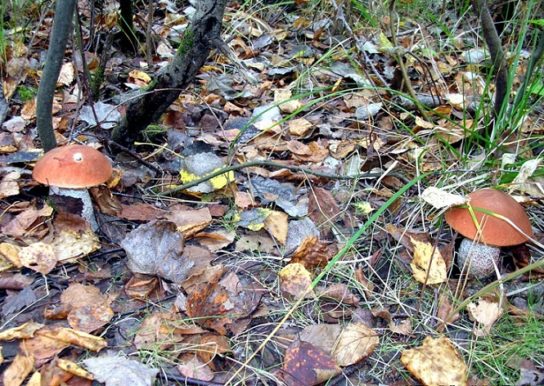
The name of the mushroom indicates that these mushrooms prefer to establish a mycorrhizal connection with aspens. But it is not so. Yes, they are found more often under these trees, but the wide variety of boletus species suggests that the species has adapted to other conditions of existence.
The yellow-brown boletus does not coexist with the aspen, it prefers to settle next to the birches. The red-headed boletus grows both in the aspen grove and next to other tree species. The fungus is not picky about the age of the forest. It grows in young groves and old well-established forests. Boletus is often found among ferns and rare holly grass.
Previously, it was believed that the boletus growth season falls on summer-autumn. Climate change has shifted the growth chart. Recently, mushrooms have been found at the end of May.
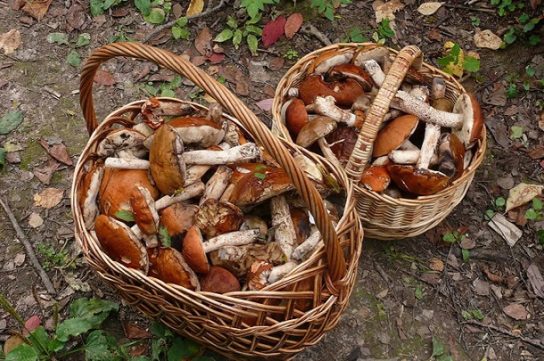
August is considered the ideal season for picking aspen mushrooms in Russia. At this time, mushroom pickers collect the most common species - the red-headed boletus. This mushroom opens the season of "hunting" for boletus boletus. The third and final wave of the harvest occurs in early autumn. By the end of the season - early November, it is already difficult to find young mushrooms, and old specimens contain colonies of larvae and are too hard for pickling and salting.
Evaluation of taste, medicinal properties, benefits and possible harm
The white boletus is an edible fruit that belongs to the second category. It is believed that it is better to marinate young fruit bodies, and more mature specimens are preferably fried or dried. This mushroom is dried, frozen, salted, and it also goes well with other relatives in one dish.
Among the useful properties are:
- the ability to cleanse the blood;
- elimination of harmful substances from the body, it works as an absorbent;
- the ability to lower cholesterol;
- restoration of immunity;
- sedative properties;
- tissue regeneration;
- restoration of intestinal microflora.
In addition, the boletus helps in the treatment of cancer.
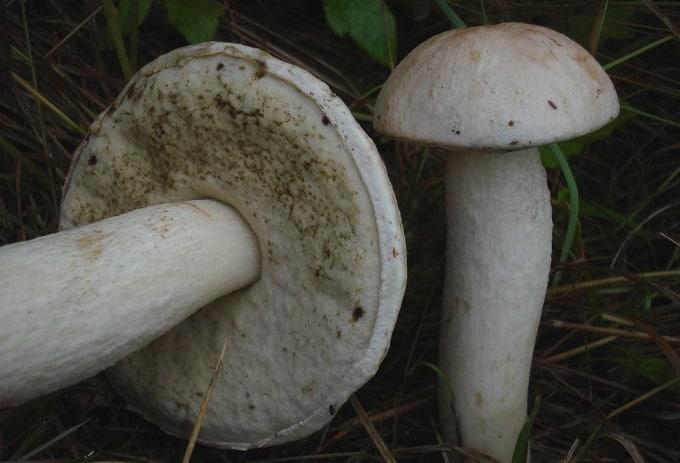
A large number of tinctures are prepared from white boletus, it is especially popular in folk medicine. The use of the product will help to cope with such diseases:
- atherosclerosis;
- oncology;
- dysbiosis;
- depression, nervous tension;
- restoration of immunity;
- anemia, improves complexion.
To prepare the tincture you will need:
- white boletus caps;
- vodka or cahors;
- glass jar.
Parts of the mushroom are cleaned and washed, cut into small pieces, placed in a jar, then poured with the selected alcohol composition. The sealed container is placed in a dark place for 15 days. After that, the resulting mass should be filtered and drunk at 3 tbsp. l. in a day. The course of admission is up to 3 months.
Boletus species
Most types of boletus are edible and tasty, but there are also false boletus. But to make mushroom hunting more interesting, study the differences and individual properties of their varieties.
Boletus red
This edible mushroom is distinguished by the fact that it does not choose a certain type of tree as a mycorrhizal partner, but is "friends" with a variety of deciduous giants: oak, beech, poplar, aspen, birch, willow. Red boletus can be described as follows:
- The diameter of the cap ranges from 4 to 15 cm, in some cases it reaches 30 cm.
- The height of the leg can be up to 15 cm, its thickness is from 1.5 to 5 cm.
- The color of the cap is bright red, red-brown, red. The skin is firmly attached to the pulp, smooth or slightly velvety to the touch.
- The outer layer of the leg is covered with gray-white scales, which, as the mushroom matures, acquire a brown tint.
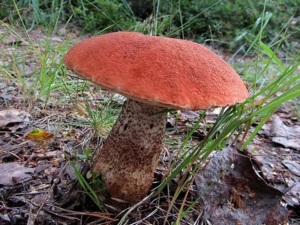 If you cut the red boletus, at this point the color will change first to blue, then black. A group or a single mushroom can be found in deciduous or mixed forests. He especially loves young growth of aspen, various ditches and forest paths. The red boletus grows throughout the Eurasian territory, in the tundra it chooses places under dwarf birches. In our vast homeland, it can be seen everywhere - from the European part to the Far East, including the Caucasus. You can harvest the red boletus during the harvest season: from June to October.
If you cut the red boletus, at this point the color will change first to blue, then black. A group or a single mushroom can be found in deciduous or mixed forests. He especially loves young growth of aspen, various ditches and forest paths. The red boletus grows throughout the Eurasian territory, in the tundra it chooses places under dwarf birches. In our vast homeland, it can be seen everywhere - from the European part to the Far East, including the Caucasus. You can harvest the red boletus during the harvest season: from June to October.
Boletus yellow-brown
It is an edible mushroom that is in symbiosis with birches. Low-lying forest belts with a predominance of aspen and birch are chosen as a place of growth; they can be found in spruce-birch forests, pine forests. They grow in temperate areas. Description:
- The diameter of the cap is from 5 to 15 cm, sometimes 25 cm.
- The leg is high, reaching 8-22 cm, its thickness is about 2-4 cm.
- The hat is sandy-orange or yellowish-brown.
- In young mushrooms, the dry skin of the cap often hangs over the edge.
- The leg has a white or grayish tint, covered with granular brown scales, blackening as it grows.
Usually grows singly. If the leg is cut off, at this point it will turn pink, then blue, after which it will acquire a purple hue, sometimes green. This type of mushroom is collected all summer long. But sometimes they are met at the end of November.
Pine redhead
Belongs to edible mushrooms. He has a reddish-brown hat with a dark crimson shade, which distinguishes him from his fellows. Grows near pine and bearberry. Description:
- The diameter of a dry velvety cap reaches 15 cm.
- The length of the leg grows up to 15 cm, its thickness reaches 5 cm. Small, brownish scales are located on the leg of the redhead.
At the cut site, the flesh turns blue, then turns black. This species is less common than the red boletus. Grows in humid coniferous forests in the temperate latitudes of Europe.
Spruce redhead
It is an edible mushroom. It can be described as follows.
- The hat has a deep brown-chestnut color, hangs slightly from the edge, its diameter is from 3 to 10 cm.
- The leg in the form of a cylinder has light brown scales on the surface, slightly expanding towards the base. The length reaches 8-14 cm, the thickness is 1.5-3 cm.
The flesh of the redhead is dense, white, it becomes dark on the cut. Spruce boletus are grouped in coniferous forests, as a rule, under spruce trees, they are found in oak forests, mixed forests. The harvest season begins in July and lasts until October.
Black-scale boletus
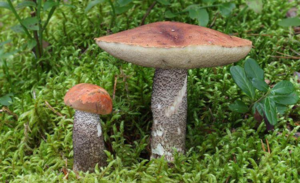 This edible mushroom has a reddish orange, dark reddish or brick red cap. In a young mushroom, it is semicircular, dry, slightly velvety. Over time, it acquires a cushion shape, becomes smooth, reaches from 4 to 12 cm in diameter. Reddish scales are located on a 13-18 cm high leg. The flesh is firm, white; when cut, it turns purple or gray-black.
This edible mushroom has a reddish orange, dark reddish or brick red cap. In a young mushroom, it is semicircular, dry, slightly velvety. Over time, it acquires a cushion shape, becomes smooth, reaches from 4 to 12 cm in diameter. Reddish scales are located on a 13-18 cm high leg. The flesh is firm, white; when cut, it turns purple or gray-black.
So, we learned that the boletus mushroom is edible. It owes its name to aspen, since it is closely connected with its roots, and the hat resembles an autumn leaf in color. And each species has its own characteristics and differences from others.
Boletus mushroom and its species. Boletus false and its differences
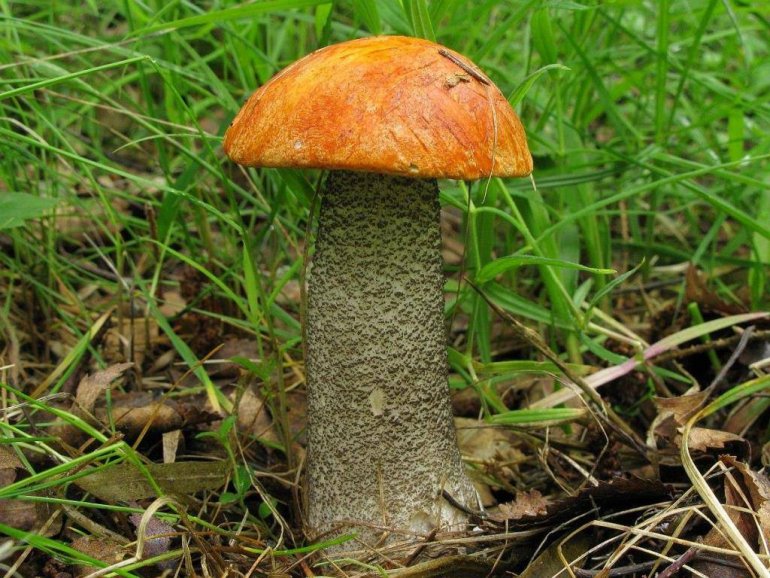
Aspen boletus (redheads, aspen) is a group of species of boletus mushrooms from the genus Obabok (Leccinum) differing in similar characteristics. The people also use the names red mushroom, krasyuk, krasnik for them, which often introduces confusion among novice mushroom pickers. The boletus mushroom more often snuggles up to the paths, beckons with bright button-hats on high legs and massively “surrenders without a fight”. With this, he mainly captivates both beginners and experienced fans of "quiet hunting". At a young age, aspen mushrooms look like porcini mushrooms. They grow near them and are not much inferior to them in taste, therefore they are considered no less popular.
How to distinguish between different types of boletus
Red boletus
The red boletus (Leccinum aurantiacum), which grows mainly under the aspen and birch, is considered to be the classic representative of the boletus. This species has a very expressive appearance. In particular, a noticeable (though not poisonous-bright) red-orange or brick-colored hat. And also a leg covered with white or grayish scales.
Redhead oak
The boletus, or redhead, oak (Leccinum quercinum), which forms mycorrhiza with oak and grows in the corresponding forests, looks no less representative. Its velvety red-brick (closer to brown) cap sits on a leg covered with soft brown scales.
Black-scaly boletus mushroom
A similar appearance, but with darker, almost black, scales on the leg, is also characteristic of the black-scaly boletus (Leccinum atrostipiatum). However, this mushroom is much less common and, as a rule, is mistaken for a similar species of boletus.
Yellow-brown boletus mushroom
Yellow-brown boletus (Leccinum versipelle) differs from the listed species in a brighter cap color (from yellow-gray to light orange). And also those that prefers moist soil of mixed spruce-birch (birch-aspen) forests. There he often grows next to ferns. In damp places, only in the vicinity of spruce and much less often, there is also a boletus, or redhead, spruce (Leccinum piceinum) with an orange-brown cap.
Less common types
Pine redhead (Leccinum vulpinum), white boletus (Leccinum percandidum) and colored-footed boletus (Tylopilus chromapes) are uncharacteristic for other aspen mushrooms. The first has a cap of an “unnatural” dark crimson color, which is especially pronounced in adult mushrooms, and a “velvety” leg densely covered with brown scales.
It grows in coniferous forests, especially on mosses. Pine boletus is considered a rather rare species, but mushroom pickers claim that its fruiting depends largely on suitable weather conditions. The white boletus (Leccinum percandidum) is characterized by a completely "incredible" white color of the cap and leg for the boletus, which does not change with age. This species can be found more often in deciduous and mixed forests in the north, in Siberia and in the tundra. By the way, it usually grows in the neighborhood of dwarf birches.
Typical signs of these mushrooms
Some mushroom pickers, by the way, argue that the surface of the cap of this boletus in wet weather becomes sticky to the touch, and that it has a snow-white color only in the shade. And in more illuminated places it can take on a grayish or pinkish tint. Colored-legged boletus, oddly enough, for its typical appearance is also referred to as boletus. But he is not included in the Obabok genus. A distinctive feature of this mushroom is the color of the leg - a white-pink tint in its upper part smoothly turns into an expressive ocher-yellow at the base. The caps of young colored-legged boletus boletuses have the usual convex shape, but in adult specimens they are slightly flattened, and are colored, albeit dark, but nevertheless closer to pink, in color.
A typical property of most boletus boletus is the color change on the cut. Initially white, it turns slightly pink, then takes on a gray or purple hue. Black spots also appear on the sponge and on the legs from touch. A completely different picture is observed on the cut of colored-legged and pine boletus. The white flesh of the former does not change color at all. But at the base of the leg it has a distinct buffy-yellow spot. And in the second, the color of the cap on the break also does not change, the spongy layer turns red from pressure. In this case, the leg is colored at the base in olive, and closer to the center - in a red tint.
The benefits and harms of boletus for health
The boletus contains a large amount of protein and fiber, micro and macro elements, they are useful and quickly saturate. Unfortunately, animal protein is absorbed faster, but boletus boletus contains important amino acids, and they are obtained free of charge, you just need to spend time in the fresh air to harvest, which in itself is good for the body.
Vitamins A, E, C, PP, group B are in a bioavailable form in the boletus mushroom. Salt, potassium, iron and manganese are essential for all organs and systems of the human body.
If you pick mushrooms away from industrial buildings, then these mushrooms do not carry any harm to a healthy person.
People with kidney, digestive system and liver problems use with caution, like any other high-protein food
If there are health problems, then they do not use the mushroom itself, but the boletus broth. Outwardly, it looks like a witch's potion, dark and cloudy, but at the same time it has a beneficial effect on the digestive tract, does not irritate the stomach and intestines.
What inedible mushroom can be confused with boletus
The boletus is very unique in its appearance, and therefore it is quite difficult to confuse it with other mushrooms. But inexperienced mushroom pickers may still have some difficulties with its definition.In nature, there is perhaps only one inedible mushroom that bears some resemblance to the boletus, and it is called the bile mushroom (Tylopilus felleus).
The gall fungus is not poisonous, it is simply inedible due to the very bitter taste of the pulp. Among the main differences between this mushroom and the boletus is a brown cap, a tubular layer that has a pinkish tint in adult mushrooms, as well as a leg on which there are no scales, but often there is a mesh pattern. On the cut, the mushroom does not darken, only occasionally a reddish tint may appear in the pulp. The gall fungus is quite widespread in Russia, it grows in coniferous and deciduous forests, and likes to appear at the base of trees. Most often, the gall mushroom is confused with a boletus or a porcini mushroom, but it does not have a very big resemblance to a boletus, you can see for yourself by looking at his photo.
Edible mushroom very similar to boletus
The genus Leccinum includes a considerable number of mushrooms, among which there are not only boletus, but also boletus. It is one of the species of boletus, and specifically the harsh boletus (Leccinum duriusculum) in many ways is very similar to the boletus. This mushroom forms mycorrhiza with aspens and poplars, has a dense pulp structure, which darkens on the cut, sometimes there are bluish spots at the base of the leg, and in general its appearance resembles a typical boletus.
Have you noticed how much these mushrooms have in common? Well, now it's worth mentioning the differences. The first thing that catches your eye is the hat, in the harsh boletus it is gray-brown or brown, only spruce or oak aspen boletus can have similar colors. On a cut, the flesh of a boletus does not darken immediately, initially it acquires a reddish tint and only later becomes almost black. The harsh boletus is rarely wormy. This is associated primarily with its dense pulp. He has the greatest resemblance to the boletus at a young age, when his hat has not yet opened. In terms of nutritional value, this boletus is not inferior to boletus.
Common boletus (Latin Leccinum scabrum)
Name Common boletus.Latin name: Leccinum scabrum.Other names: Birch, Birch obabok.Department: Basidiomycota.Class: Agaricomycetes.Order: Boletovye.Family: Boletovye.Genus: Leccinum.Edible mushroom.
 Name Common boletus.Latin name: Leccinum scabrum.Other names: Birch, Birch obabok.Department: Basidiomycota.Class: Agaricomycetes.Order: Boletovye.Family: Boletovye.Genus: Leccinum.Edible mushroom.
Name Common boletus.Latin name: Leccinum scabrum.Other names: Birch, Birch obabok.Department: Basidiomycota.Class: Agaricomycetes.Order: Boletovye.Family: Boletovye.Genus: Leccinum.Edible mushroom.
Scientific synonyms
Boletus albus
Boletus scaber
Ceriomyces scaber
Gyroporus scaber
Krombholziella subcinnamomea
Leccinum rigidipes
Leccinum rotundifoliae
Leg
30-170 mm high, 10.5-30 mm thick, central with respect to the cap, cylindrical, often thinner at the point of germination of the tubular layer, slightly thickened at the base, whitish with brownish almost black scales, especially pronounced in mature fruit chalk.
Hat
20.5-200 mm in diameter, in young rafts it has a semicircular shape, becomes cushion-shaped as it matures. The color can be completely different, from light yellow to dark brown, smooth to the touch, with an increase in environmental humidity, it can absorb a lot of moisture.
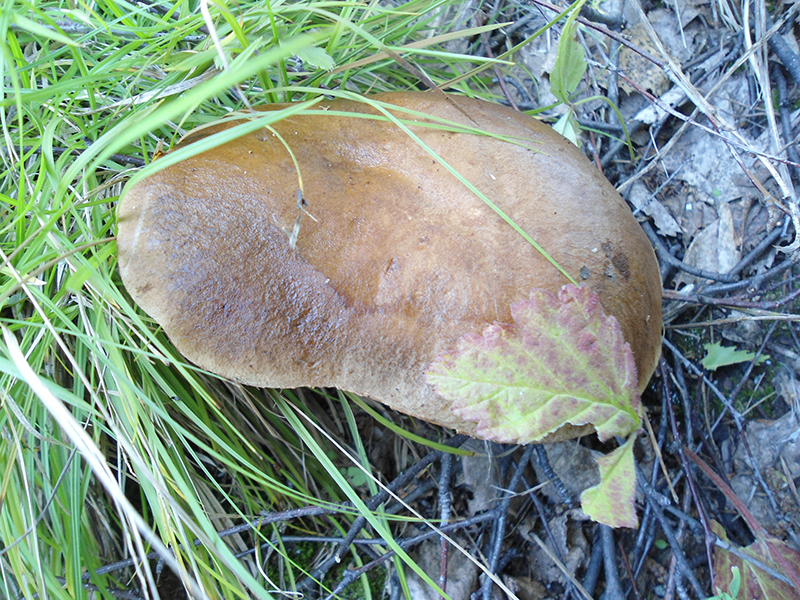
Hymenophore
The tubules of the hymenophore in young fruits are white, when ripe they acquire a gray-cream shade, 10-25 mm long, at the site of germination to the stem, the hymenophore is free or notched. The pores are small and rounded.
White in color, without a pronounced mushroom taste and smell. If damaged, the color does not change.
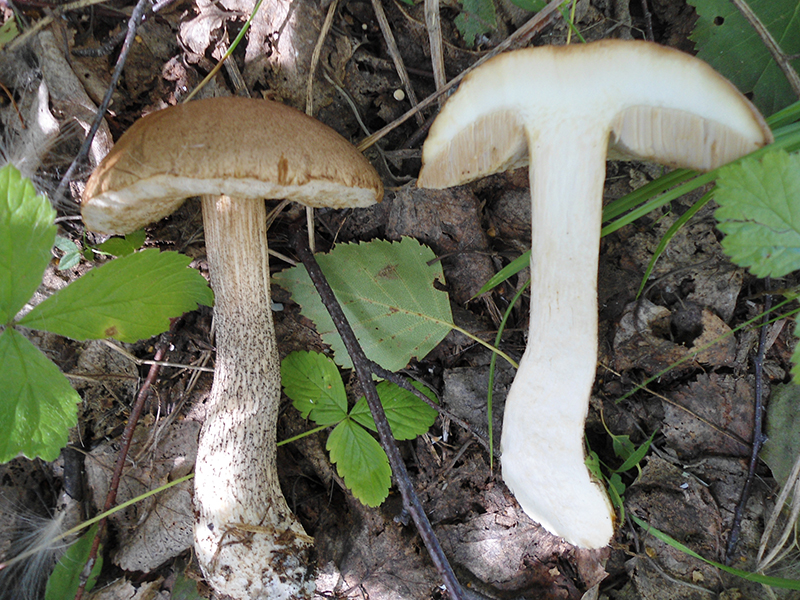
14-20 x 4-6 µm, longitudinally spindle-shaped, smooth, yellowish-brown.
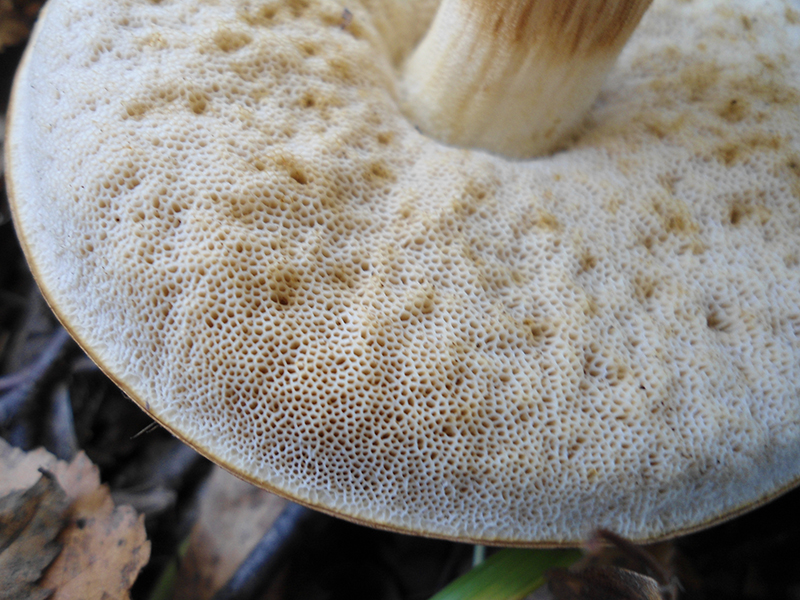
Habitat
Forms mycorrhiza with birch.It grows both in mixed and deciduous forests, prefers the outskirts and edges of the forest, with sparse grass and good illumination.
Similarity
Similar species are, first of all, Marsh boletus (Leccinum holopus) and Black boletus (Leccinum melaneum).

